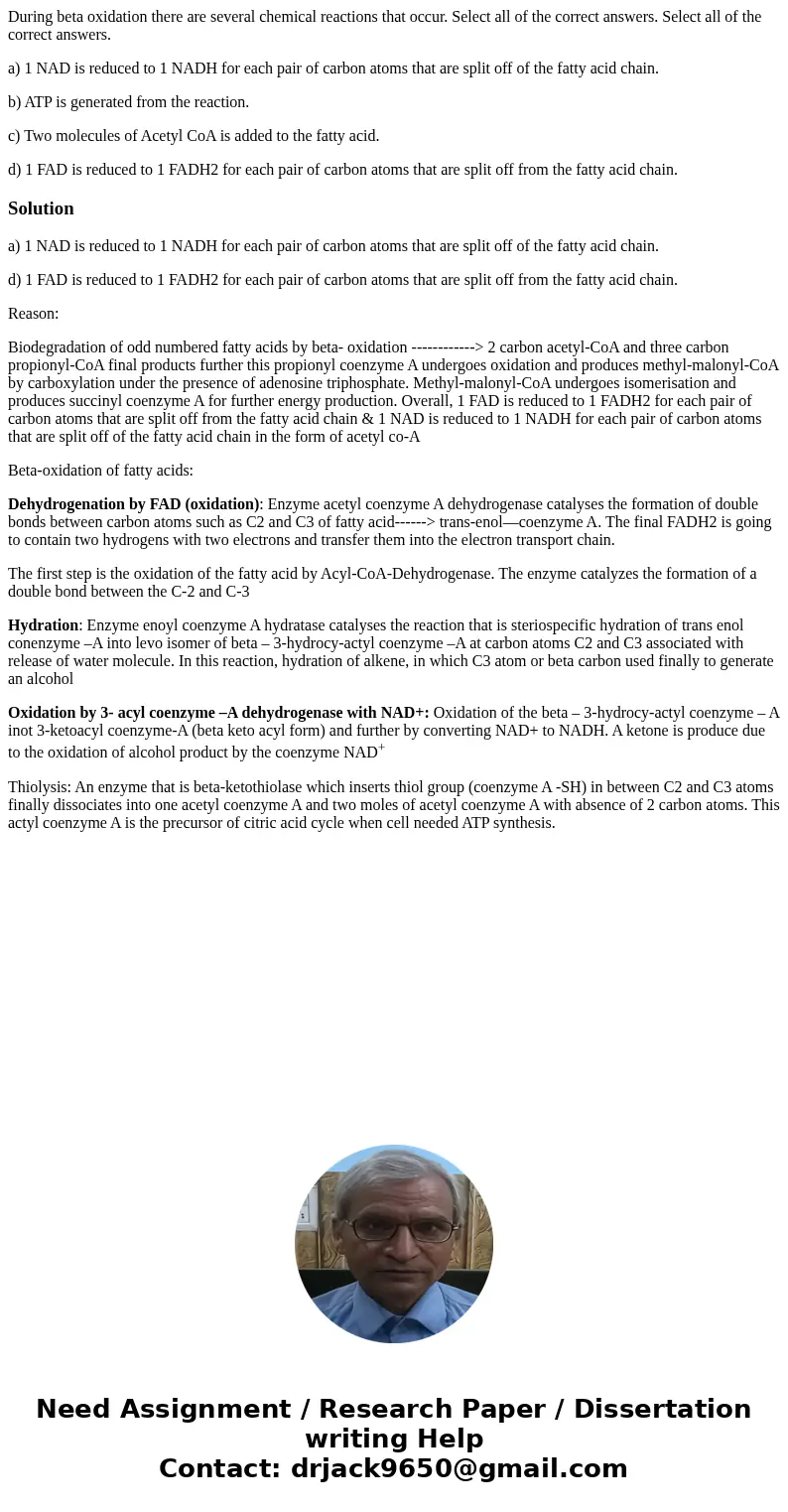During beta oxidation there are several chemical reactions t
During beta oxidation there are several chemical reactions that occur. Select all of the correct answers. Select all of the correct answers.
a) 1 NAD is reduced to 1 NADH for each pair of carbon atoms that are split off of the fatty acid chain.
b) ATP is generated from the reaction.
c) Two molecules of Acetyl CoA is added to the fatty acid.
d) 1 FAD is reduced to 1 FADH2 for each pair of carbon atoms that are split off from the fatty acid chain.
Solution
a) 1 NAD is reduced to 1 NADH for each pair of carbon atoms that are split off of the fatty acid chain.
d) 1 FAD is reduced to 1 FADH2 for each pair of carbon atoms that are split off from the fatty acid chain.
Reason:
Biodegradation of odd numbered fatty acids by beta- oxidation ------------> 2 carbon acetyl-CoA and three carbon propionyl-CoA final products further this propionyl coenzyme A undergoes oxidation and produces methyl-malonyl-CoA by carboxylation under the presence of adenosine triphosphate. Methyl-malonyl-CoA undergoes isomerisation and produces succinyl coenzyme A for further energy production. Overall, 1 FAD is reduced to 1 FADH2 for each pair of carbon atoms that are split off from the fatty acid chain & 1 NAD is reduced to 1 NADH for each pair of carbon atoms that are split off of the fatty acid chain in the form of acetyl co-A
Beta-oxidation of fatty acids:
Dehydrogenation by FAD (oxidation): Enzyme acetyl coenzyme A dehydrogenase catalyses the formation of double bonds between carbon atoms such as C2 and C3 of fatty acid------> trans-enol—coenzyme A. The final FADH2 is going to contain two hydrogens with two electrons and transfer them into the electron transport chain.
The first step is the oxidation of the fatty acid by Acyl-CoA-Dehydrogenase. The enzyme catalyzes the formation of a double bond between the C-2 and C-3
Hydration: Enzyme enoyl coenzyme A hydratase catalyses the reaction that is steriospecific hydration of trans enol conenzyme –A into levo isomer of beta – 3-hydrocy-actyl coenzyme –A at carbon atoms C2 and C3 associated with release of water molecule. In this reaction, hydration of alkene, in which C3 atom or beta carbon used finally to generate an alcohol
Oxidation by 3- acyl coenzyme –A dehydrogenase with NAD+: Oxidation of the beta – 3-hydrocy-actyl coenzyme – A inot 3-ketoacyl coenzyme-A (beta keto acyl form) and further by converting NAD+ to NADH. A ketone is produce due to the oxidation of alcohol product by the coenzyme NAD+
Thiolysis: An enzyme that is beta-ketothiolase which inserts thiol group (coenzyme A -SH) in between C2 and C3 atoms finally dissociates into one acetyl coenzyme A and two moles of acetyl coenzyme A with absence of 2 carbon atoms. This actyl coenzyme A is the precursor of citric acid cycle when cell needed ATP synthesis.

 Homework Sourse
Homework Sourse